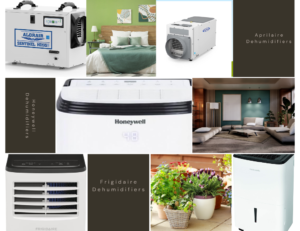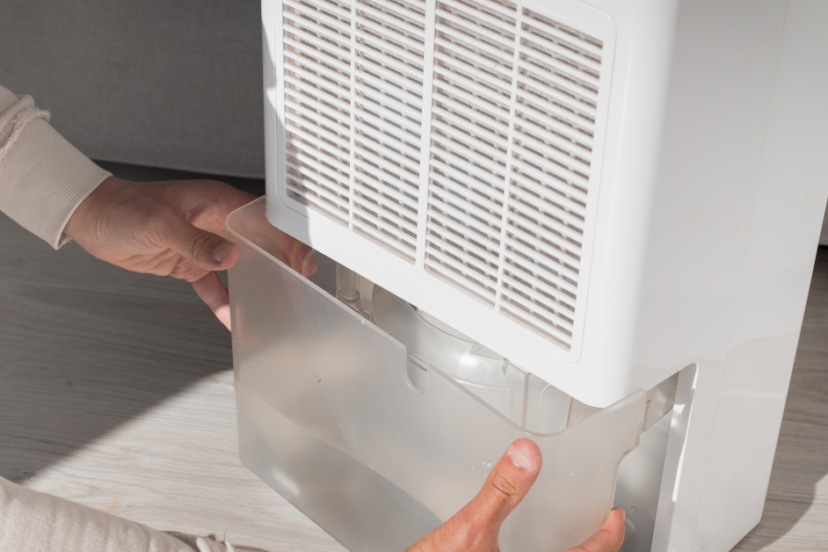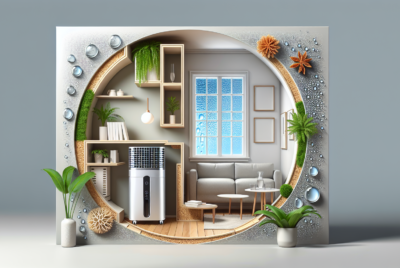Whole House Dehumidifiers: An In-Depth Guide
"We may earn a commission for purchases made using our links. Please see our disclosure to learn more."
Whole house dehumidifiers can be a game-changer for your living environment. Picture this: you come home from a long day, only to be greeted by air so thick and heavy, you feel like you could cut it with a knife. This isn’t how your personal sanctuary should feel. Humidity shouldn’t be an unwelcome guest in your home. Thankfully, dehumidifiers are the tool you need to reclaim your comfortable space.
Understanding Whole House Dehumidifiers
What is a Dehumidifier?
Think of a dehumidifier like a special filter for your home. It takes in the damp, heavy air and releases it back into your space, lighter and much more comfortable. Just as a filter removes impurities from your drinking water, a dehumidifier takes the ‘extra’ out of the air, leaving it feeling just right.
Types of Dehumidifiers
When it comes to dehumidifiers, there isn’t a one-size-fits-all solution. Like the various tools in a toolbox, different dehumidifiers have different ways of handling moisture. Some, like refrigerant dehumidifiers, work by cooling the air, causing it to release its moisture. It’s a bit like how a cold glass of lemonade “sweats” on a hot day. Others, like desiccant dehumidifiers, use special materials to absorb moisture from the air.
What Makes a Whole House Dehumidifier Unique?
The real star of the show, though, is the whole house dehumidifier. Unlike portable units that work in one room at a time, a whole house dehumidifier takes care of your entire living space. It’s like having a team of cleaners tidying up every room simultaneously instead of moving from one area to the next.
This is what makes comprehensive dehumidification systems so beneficial. They ensure uniform comfort throughout your home, not leaving a single room at the mercy of oppressive humidity. So, are you ready to make your home a no-go zone for excess moisture? Let’s find out more about how these devices can transform your living environment.
The Science Behind Humidity and Dehumidification
Defining Humidity
When we think about humidity, we often envision a sultry summer day with the air so heavy you feel like you’re wading through it. In scientific terms, humidity refers to the quantity of water vapor in the air. More than just a physical sensation, humidity plays a critical role in shaping our comfort, our health, and even the condition of our homes.
How Dehumidifiers Work
Think of dehumidifiers as specialized air sponges. These devices operate by drawing in moisture-laden air, cooling it to transform the vapor into liquid (much like condensation on a chilled beverage can), and then collecting the resulting water in a tank. The dry air is then re-warmed and released back into your space. Consequently, the goal of achieving humidity control for the entire home evolves from an abstract idea into a tangible reality.
Why Control Humidity in Your Home?
If you’re wondering why it’s essential to control humidity in your home, imagine trying to balance on a tightrope. Excessive humidity, and it’s like living in a marshland; too little, and your skin starts to feel parched. Maintaining the right humidity levels is critical to prevent health problems, safeguard your home, and enhance your overall comfort.
Implications of Humidity: Health and Home
The Health Risks Associated with High Humidity
Let’s delve into the more serious aspects. High humidity doesn’t just make your home uncomfortably balmy—it can also pose substantial health risks. Overly humid environments are prime breeding grounds for dust mites, mold, and mildew, all of which can contribute to a range of health issues from allergies to asthma. Opting for full-home dampness control solutions like whole house dehumidifiers can transform your living space into a healthier environment.
The Damaging Effects of Humidity on Your Home
Your home is also at risk when humidity levels soar. Have you ever noticed a musty odor emanating from a damp basement? That’s your house’s silent plea for a dehumidifier. Persistent high humidity can wreak havoc on your home’s structural integrity, promoting mold growth and even triggering rot. An investment in a central dehumidifying unit serves as a shield against such destructive elements.
How Humidity Impacts Comfort and Energy Efficiency
When it comes to home comfort, high humidity is an unwelcome guest. It can cause a stuffy atmosphere and leave your skin feeling clammy, which is not the cozy, welcoming ambiance most homeowners strive for. Moreover, it can overwork your air conditioning unit, forcing it to cool moist air rather than dry air. By installing a dehumidification system for the entire house, your AC unit can operate more efficiently, potentially leading to long-term energy savings.
Unraveling Whole House Dehumidifiers: Notable Features
Size and Capacity of Dehumidifiers
Choosing the right size for your whole house dehumidifier is akin to selecting the perfect outfit—it needs to fit just right. Picking a dehumidifier that’s too small might result in it running overtime without a significant reduction in humidity levels. Conversely, a too-large unit could lead to wasteful consumption of energy. How do you find the right fit? It’s crucial to consider variables such as the square footage of your house, its typical humidity levels, and the number of occupants. For example, a 1,500 square foot house with moderate humidity might require a dehumidifier capable of extracting around 14-16 pints of water per day. Your ultimate goal is to strike a balance with a comprehensive dehumidification system that optimally serves your requirements.
Energy Efficiency: Cost and Environmental Considerations
While it’s inevitable that dehumidifiers, like any other appliance, consume energy, this doesn’t imply a surge in your electricity bills or an adverse impact on the environment. Many modern whole house dehumidifiers are built with energy conservation at the forefront. Look for units that bear the Energy Star certification or possess other energy-saving features. This approach not only curbs your utility costs but also contributes towards reducing your carbon footprint.
Noise Levels: Ensuring Quiet Operation
The last thing you want is a dehumidifier that’s as noisy as a bustling city street. Thankfully, numerous home-wide moisture regulation devices prioritize quiet operation. Consider the unit’s decibel rating when shopping—most quiet dehumidifiers operate within the range of 50-60 decibels, similar to the noise level of a typical conversation or background music. This way, you ensure that the tranquillity of your living environment isn’t compromised in the quest for optimal humidity levels.
The Role of a Built-in Humidistat
Think of a built-in humidistat as your personal indoor weather forecaster. This feature allows your whole house dehumidifier to automatically monitor and adjust the humidity levels, facilitating a consistently comfortable environment without manual intervention from your side.
Brand Spotlight: Unveiling Prominent Whole House Dehumidifier Brands
The journey towards choosing the perfect product starts with understanding the brands behind them. With whole house dehumidifiers, the story is no different. In the ensuing section, we’ll illuminate the strengths of the top brands in this sector. From the unique features they offer to their dedication to customer satisfaction, we’ll explore what sets these brands apart in the competitive landscape of dehumidification systems for the entire house. Stick around to learn more!
Diving Deep into Aprilaire Dehumidifiers
 Aprilaire, a brand that has etched its name in the arena of air quality solutions, offers an impressive range of whole house dehumidifiers. Known for their top-notch performance and reliability, Aprilaire dehumidifiers come in various sizes, from compact units suitable for smaller homes to more powerful models capable of tackling high levels of humidity in large residences. Their products are Energy Star rated, which attests to their commitment to energy efficiency. Perhaps one of the most unique aspects of Aprilaire’s offerings is their emphasis on integrating with your home’s existing HVAC system, making for a seamless, whole-home dehumidification experience.
Aprilaire, a brand that has etched its name in the arena of air quality solutions, offers an impressive range of whole house dehumidifiers. Known for their top-notch performance and reliability, Aprilaire dehumidifiers come in various sizes, from compact units suitable for smaller homes to more powerful models capable of tackling high levels of humidity in large residences. Their products are Energy Star rated, which attests to their commitment to energy efficiency. Perhaps one of the most unique aspects of Aprilaire’s offerings is their emphasis on integrating with your home’s existing HVAC system, making for a seamless, whole-home dehumidification experience.
Spotlighting Honeywell’s Collection
 When you think about Honeywell, the image of a pioneer in home comfort solutions comes to mind. Their comprehensive dehumidification systems are no exception. Honeywell’s units are designed with customer convenience at the heart. Features like LED control panels, auto shut-off and restart, and washable filters enhance the user experience. Their dehumidifiers are capable of serving spaces of various sizes and are Energy Star certified, further solidifying Honeywell’s commitment to energy conservation and environmental sustainability.
When you think about Honeywell, the image of a pioneer in home comfort solutions comes to mind. Their comprehensive dehumidification systems are no exception. Honeywell’s units are designed with customer convenience at the heart. Features like LED control panels, auto shut-off and restart, and washable filters enhance the user experience. Their dehumidifiers are capable of serving spaces of various sizes and are Energy Star certified, further solidifying Honeywell’s commitment to energy conservation and environmental sustainability.
Examining Frigidaire’s Assortment
 Frigidaire, a household name in home appliances, extends its reputation for quality and innovation to its whole house dehumidifiers. Their models come equipped with a range of features, including digital humidity readouts, 24-hour on/off timers, and control locks. A stand-out aspect of Frigidaire’s dehumidifiers is their portable design, enabling easy movement between rooms if needed. In addition, their units are recognized for quiet operation, allowing you to maintain a peaceful home environment while achieving optimal humidity control.
Frigidaire, a household name in home appliances, extends its reputation for quality and innovation to its whole house dehumidifiers. Their models come equipped with a range of features, including digital humidity readouts, 24-hour on/off timers, and control locks. A stand-out aspect of Frigidaire’s dehumidifiers is their portable design, enabling easy movement between rooms if needed. In addition, their units are recognized for quiet operation, allowing you to maintain a peaceful home environment while achieving optimal humidity control.
Deciphering Installation and Maintenance of Whole House Dehumidifiers
A Step-by-Step Guide to Installing Whole House Dehumidifiers
Installation of whole house dehumidifiers may seem daunting, but with a step-by-step guide, you can ensure a smooth setup. First, identify the best location in your home for installation, ideally near your HVAC system for easy integration. You’ll then need to connect the unit to a power source, followed by attaching the drain hose to direct the collected water to a suitable drainage point. It’s also important to connect the dehumidifier to your home’s air ducts to ensure even distribution of dehumidified air. While this process is generally straightforward, consulting with a professional installer or technician can provide added peace of mind.
Best Practices for Regular Maintenance
Maintaining your central dehumidifying unit is crucial to ensure its long-term effectiveness and durability. Regular maintenance generally involves checking and cleaning or replacing the filter periodically, generally every 6-12 months depending on the model and usage. It’s also essential to inspect the drain system to ensure it’s free from blockages, as well as to clean the coils to optimize efficiency. Regular check-ups from a professional technician can also be beneficial in identifying and addressing any potential issues early.
Troubleshooting: Common Problems and Solutions
Every now and then, you might encounter issues with your dehumidification system for the entire house. For instance, if your unit is not effectively reducing humidity levels, it may be due to a dirty filter or an issue with the fan motor. Or, if your dehumidifier is not turning on, it could be a problem with the power supply or the humidistat. While some issues can be resolved with simple fixes like cleaning or resetting the unit, others may require professional repair. In all cases, refer to your unit’s user manual or contact customer support for detailed guidance.
Frequently Asked Questions about Whole House Dehumidifiers
Unraveling Cost-Related Queries
When it comes to whole house dehumidifiers, questions about cost are common. This can span the initial purchase price, installation expenses, and ongoing energy and maintenance costs. While the upfront cost might seem steep for some models, remember to consider the potential savings on your energy bill and the long-term benefits of improved air quality in your home.
Decoding Performance and Efficiency
Curious about how well these full-home dampness control solutions really work? Factors such as the unit’s capacity (measured in pints of moisture removed per day), the size of your home, and the level of humidity all play a role in a dehumidifier’s performance. Energy efficiency, often indicated by an Energy Star rating, tells you how much moisture the unit can remove per unit of energy consumed.
Addressing Common Concerns
It’s natural to have concerns when investing in a new appliance. Will it be too noisy? Will it fit in my home? Can I maintain it myself? These are all valid questions and most brands provide detailed specifications and customer support to help address such queries. Remember, a well-informed buyer is a happy buyer.
Making the Decision: Is a Whole House Dehumidifier Right for You?
Assessing Your Home’s Needs
To determine if a whole house dehumidifier is right for you, start by evaluating your home’s needs. Are certain areas of your home noticeably damp? Have you experienced issues with mold or mildew? Is the air often heavy and uncomfortable? If yes, a whole house dehumidifier could be a good investment.
Considering Your Budget
Of course, budget is an important factor in any decision. When considering a whole house dehumidifier, it’s essential to think beyond just the upfront cost. Consider also the potential savings in energy bills, health benefits, and the comfort of living in a home with controlled humidity.
Final Thoughts
Investing in a whole house dehumidifier can be a significant decision, but one that brings numerous benefits. From improved air quality to a more comfortable living environment, these devices can truly transform your home. So, weigh your options, consider your needs, and make the choice that’s right for you. Remember, a home is not just a place, it’s a feeling, and every bit of comfort counts.




